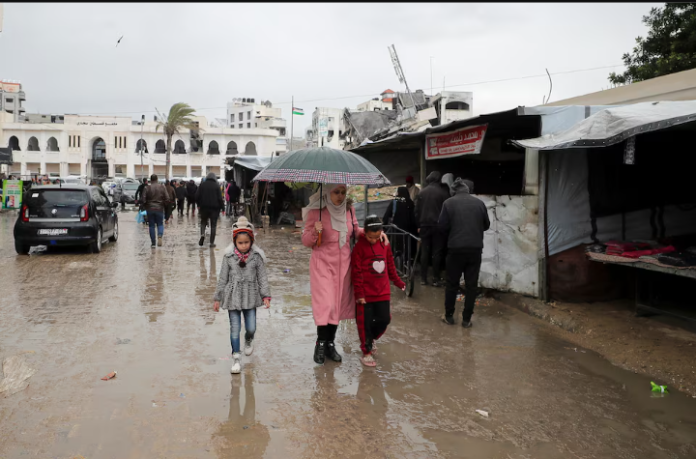As the Gaza Strip endured a relentless winter storm, with heavy rains and fierce winds battering its makeshift homes, another storm loomed—this time political. U.S. President Donald Trump’s controversial announcement about plans to seize Gaza and expel its residents ignited a wave of defiance among Palestinians, reinforcing their resolve to stay on their land, no matter the circumstances.
Weathering the Storm—Literally and Politically
In the early hours of Thursday, strong winds tore through the Gaza Strip, flooding displacement camps and sweeping away the fragile plastic sheets that served as roofs for thousands of homeless families. Yet, despite the devastation, the people of Gaza remained steadfast.
Qassem Abu Hassoun, a resident of Rafah in southern Gaza, described the harrowing experience. “Despite the rain, the cold, and everything we have lost, we are staying. This is our land, and we will never leave,” he said as he stood amid the wreckage.
His family, like many others, had returned to the ruins of their home after a ceasefire was declared on January 19. Though the shelter was barely habitable, they had no intention of abandoning it again.
Trump’s Plan Met with Defiance
The storm struck just as Gazans were digesting Trump’s shocking proposal. The announcement, which suggested that the enclave could be taken over and its residents displaced, was met with fierce resistance.
“Is he out of his mind?” asked Abdel Ghani, a father of four, whose home in Gaza City was destroyed in Israeli attacks. “We are hungry and homeless, but we will not sell our land. If Trump wants to help, let him rebuild Gaza instead.”
The storm, combined with Trump’s statement, only strengthened the people’s determination. Residents bailed out floodwaters using plastic pots, patched their torn shelters, and prepared to endure whatever came next. They were not leaving—no matter what.
Israel’s Controversial “Departure Plan”
Amid the chaos, Israeli Defense Minister Israel Katz ordered the army to draft a plan for the “voluntary departure” of Gaza’s residents. The proposed initiative would reportedly offer exit options via land crossings, as well as by sea and air.
Palestinian officials, however, condemned the move. Hamas leader Basem Naim dismissed Katz’s statement as a distraction, meant to cover up Israel’s failure to achieve its war objectives. “If Israel truly wants a solution, they should lift the blockade on Gaza. Then they will see that more people will return, rather than leave,” Naim stated.
The Deep-Rooted Struggle for Gaza

The displacement of Palestinians has long been a sensitive issue in the Middle East. Under international law, forcibly expelling a population under military occupation is considered a war crime. Yet, history has shown that Gazans will not be easily uprooted.
Since the war began following Hamas’s attack on Israel on October 7, 2023, the Gaza Strip has endured relentless bombardment. According to the Gaza Health Ministry, over 47,000 Palestinians have been killed in the last 16 months. Israel, on the other hand, maintains that its actions are aimed at eradicating Hamas.
Despite the destruction, many displaced Palestinians have returned home, even to neighborhoods reduced to rubble. Their return is not just about reclaiming homes—it is about holding on to their identity, history, and land.
A Battle Beyond the Battlefield
As Gaza fights for survival against war, displacement, and natural disasters, its people refuse to surrender. Neither the storm nor Trump’s declaration will break their spirit.



